This site contains affiliate links. As an Amazon Associate, I earn a commission from qualifying purchases at no extra cost to you. Full Disclosure Here.
What is a reverse tanto blade and what is it good for? If you’ve found yourself asking that question after seeing one of these blades, you’re certainly not alone and it’s a common question to ask. Where did this blade shape come from and why was it even introduced into the market in the first place?
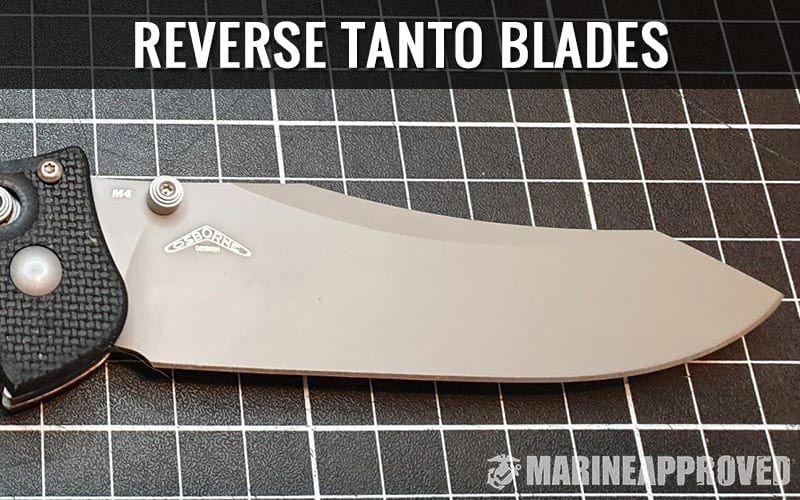
At first, it wasn’t quite clear to me as to why this blade shape exists, after all, there are many other blade shapes that are designed to perform well with options for just about anybody doing anything, but after becoming accustomed to using it and learning more about it over the years, I now understand.
The reverse tanto blade design is simply just an aesthetically pleasing design that’s something fresh and new to the market without sacrificing a single drop of utility or durability, at least that’s what it seems like on the surface, but this blade shape is much more than that, which we’ll discuss below.
First, if you haven’t read up on what a regular tanto blade is, I suggest studying up there first before continuing here, although you don’t necessarily have to.
Of course, the blade shape is only part of the equation you should be considering and before we get into the mysterious and emerging world of the reverse tanto, it’s important to note that, just all of the other blade shapes, the other factors of blade geometry apply here and can drastically impact how the blade behaves.
If you’d like to learn more about the grind of a blade, check out our knife grinds guide here. Just like the grind, the actual steel composition of the blade will also dictate its performance across use cases, and as such, if you’d like to brush up on some of the most common knife steel types, refer to our guide on blade steels here.
What is a Reverse Tanto Blade?
The reverse tanto is a very unique blade shape that is easily identifiable by simply noting its long and gradual flat belly with an upward sloping area near the tip, very similar in appearance and performance to a drop point blade belly, but with a spine that comes out flat or sometimes with a slight and gradual upward sloping angle depending on the design from the handle, reaches a hump or point, and then immediately and usually in a flat manner, falls into a harsh angle down to the tip of the blade, which is typically centered with the knife or very close to being centered.
This particular blade shape actually has very little in common with the American style tanto blades we all know and love, and honestly, its operation in the field is a lot closer to that of a drop point or clip point blade shape than it is to the American or Japanese version of the tanto.
The tip of a reverse tanto, especially that of the Osborne iteration, usually has a distinct triangular form which is known to be exceptionally durable, and since the tip of a reverse tanto is generally higher up than a drop point or clip point, its performance in penetration is closer to that of a spear point. The Bob Dozier version of the reverse tanto is sometimes closer to a Wharncliffe shape and thus can be absent of the point on the spine that creates the triangular aesthetic.
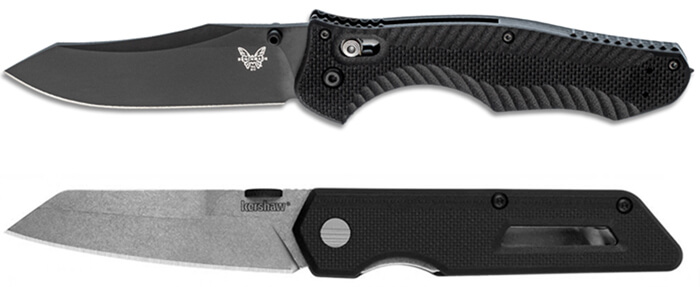
On some models, actually quite a few as of recent, such as the Benchmade Contego, the reverse tanto is modified a bit to have this sloping concave curvature to its spine, but still encompassing that same harsh angle after a turning point where it juts down to the tip. It’s almost like a clip point throughout the spine until it gets to the tip, where there is additional geometry that creates its uniqueness.
After combing through the market for reverse tanto blades, you’re going to find that there is actually a ton of creative leeway with the reverse tanto, allowing brands to create all sorts of wacky and interesting blade designs.
Something interesting you’ll note on most reverse tanto blades is that the thickness and width of the blade remains relatively similar along the spine throughout the entire blade, ensuring that the tip ends up with the same amount of total material behind it that the entire blade has. This makes holding a reverse tanto feel beefy and almost tank-like, and that’s because it generally is those things in practice.
You see, while the drop point focuses on trying to be a jack of all trades, sacrificing top-end performance and exceptional tip strength for overall utility, and the American tanto sacrifices a nice sloping belly for a shape that promotes tip strength, the reverse tanto kind of gets the best of both of these designs while also bringing an elegant uniformity of thickness throughout the blade that you don’t generally see with other blade shapes. This combination sounds hectic and confusing, but in actual operation, the reverse tanto is now one of my favorite blade shapes, especially for an EDC application.
If you’re interested, check out this video of the production for a homemade reverse tanto knife!
It’s really quite simple how the reverse tanto captivated me and many of those who give them a chance. The reverse tanto performs excellently among tasks that would require a lengthy and gradually smooth sloping cutting surface which by default already makes it a good choice for EDC for most people.
Then, considering that beefy and angular tip, the reverse tanto gives a massive boost in the piercing, stabbing, and puncturing department that you’d never actually fully enjoy from a drop point designed blade. All of this ends up in a package that’s very hefty, solid feeling, and exceptionally durable as this blade shape encompasses some of the strongest tip performance of any blade, especially in smaller applications.
In some cases, the very term “reverse tanto” is sometimes used interchangeably with “clip point”, even among some major brands that should probably be making the distinction, even if just to make the buying experience a bit easier. Although I would argue that the traditional definition of a clip point would have to have some kind of concave slope along the portion of the spine that is “clipped”, which would automatically set it apart from the reverse tanto as the spine encompasses an angular flat section to the tip, some will disagree and will lump in reverse tantos into the clip point category. In the end, it’s all semantics, but I just figured I’d make a note here so that you are aware of the situation when you’re out shopping or discussing knives.
So to wrap this section up, the truth is that while reverse tantos, for most people, are a new and interesting blade shape that gives off this exotic and tacticool aesthetic, the reverse tanto is actually very useful and very strong compared to the other popular blade shapes. In most cases, you’ll likely pay a bit of a premium for the shape, but overall, it’s something that’s fun to use, something you can trust and depend on, and something that incorporates a suite of attributes that makes a reverse tanto a solid blade shape choice in just about any scenario.
Reverse Tanto Use-Case Assessment: Advantages and Disadvantages
Use case assessments of a reverse tanto blade are a compilation of our opinions after using a myriad of different knives with different blade shapes across various situations. It’s no secret that while we have enjoyed the performance and design characteristics of all other blade shapes, the reverse tanto is certainly one of our favorites.
Although we are definitely biased towards the reverse tanto blade shape, I do strongly encourage you to check out the Marine Approved comprehensive guide on all knife blade types. Let’s talk more about all the reverse tanto uses and what it is good for and bad for below.
Reverse Tanto for Slicing and Skinning
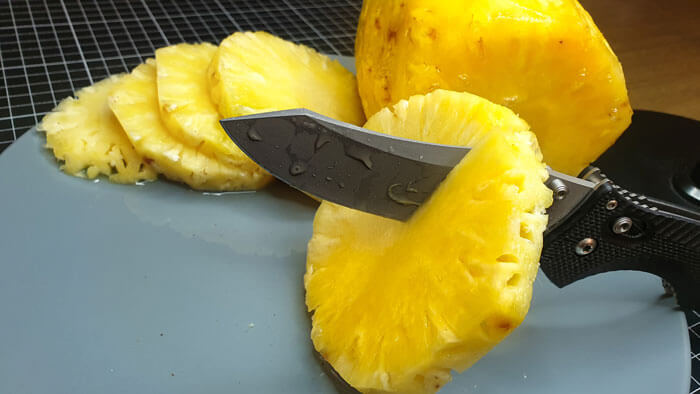
Score: 6/10
Although not the leader in this category, the reverse tanto actually performs very well in slicing and skinning as a whole, especially if you grab a model that utilizes a thinner style grind. The tip of the reverse tanto was obviously built for strength but on some of the thinner blades, that tip is very easy to use with precision and even in tight spaces, and overall, the lengthy belly of the blade just makes slicing effortless. Since the tip is usually relatively centered and pronounced, you can also make nice and neat dragging style cuts too, which makes skinning very comfortable for people that like to use a knife in that manner.
Reverse Tanto for Stabbing/puncturing
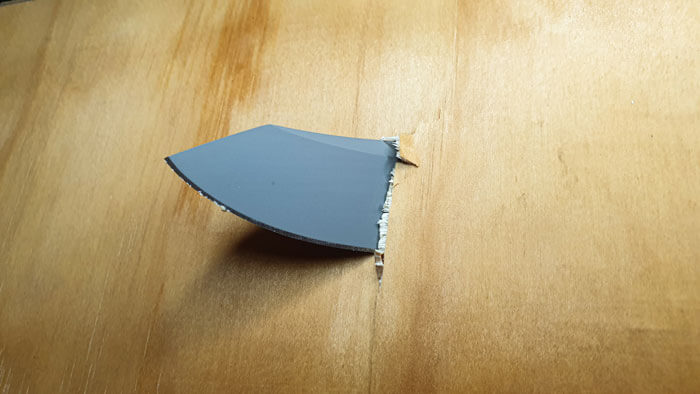
Score: 9/10
The reverse tanto is going to be one of the absolute best performers in the piercing and stabbing department. The triangular strength of the Osborne version makes the reverse tanto an exceptionally lethal and powerful tool. If you’ve seen the American version of the tanto and its piercing capabilities, you can expect very similar results out of the reverse tanto. Although it’s hard to test with so many different blades having a bunch of different variables, some may argue that the reverse tanto is actually more durable than the American tanto for piercing hard and thick materials since its tip geometry sets a ton of steel material behind and also on top of the tip. The only blade shape that might perform better in this category would be the spear point, because, you know, it’s literally designed for this.
Reverse Tanto for Batoning
Score: 6/10
Batoning isn’t exactly a stage where the reverse tanto is going to shine, especially because the most popular iterations, the Osborne reverse tanto, typically don’t have a flat spine to beat on. Of course, that long and flat belly paired up with what’s usually a rather thick spine makes for great strength when batoning, but the shape is just sometimes a bit awkward to use in terms of batoning unless you get something that’s long and flat on top. I would say this is probably the least useful category of the reverse tanto although if you had one of decent length and thickness and it was your only option, it should get the job done without much issue.
Reverse Tanto for Slashing
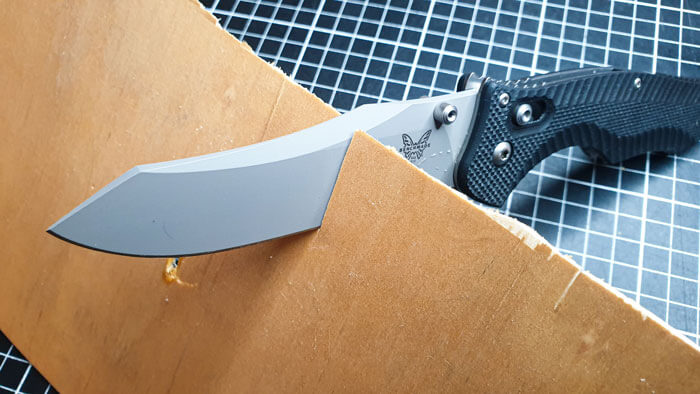
Score: 8/10
The reverse tanto makes for an excellent slashing capable blade shape. The long belly with a moderate curvature near the tip makes for a ton of very open and exposed cutting surface and when you pair that up with a tip that’s among the strongest on the market, that is also situated high up near the center of the knife, it just makes for a very ergonomically friendly and highly capable slasher.
Reverse Tanto for Whittling
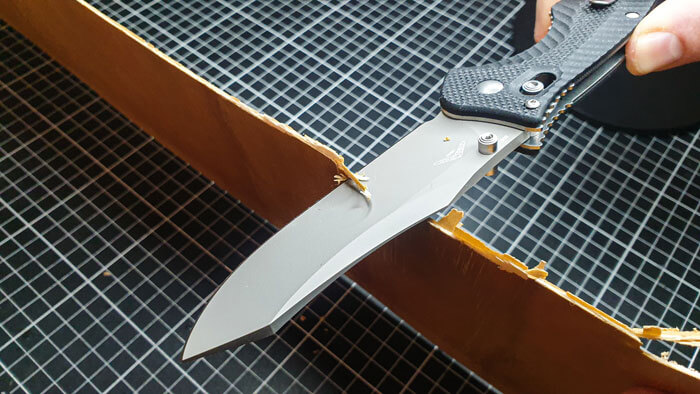
Score: 7/10
So long as you grab yourself something that isn’t extremely thick near the tip, which most reverse tantos are, you’ll have yourself a very capable whittler. The shape and ergonomics of the rather triangular nature of the reverse tanto makes those tight and precise movements a breeze and you still have a long and smooth belly with a ton of sharp real-estate for taking off your initial large amounts of material. I would say that if you like clip-points for whittling, which most people do, you’ll probably enjoy the reverse tanto for whittling as well.
Reverse Tanto for Prying
Score: 8/10
I always have to make sure I include the fact that knives, especially pocket knives, are not meant for prying, but in terms of an emergency situation where you have no other choice, a thick and beefy reverse tanto is going to give you just as much performance, if not significantly more, than any other blade shape. Simply put, most reverse tantos are leaving a ton of material on the spine and near the tip which makes its horizontal tensile strength very high, much higher than most other blade shapes.
Reverse Tanto for Everyday Carry (EDC)
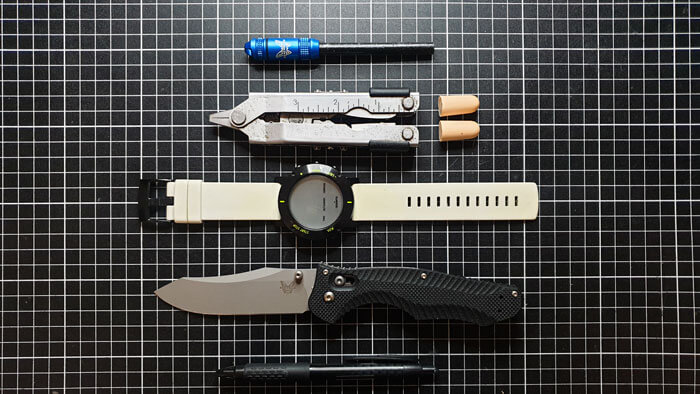
Score: 9/10
If you had asked me about how great a reverse tanto blade is for an everyday carry or EDC knife before I actually got my hands on one, I’d have ranked it significantly lower, but after actually using reverse tanto blade shapes a ton as an EDC, they’ve actually become my favorite. It’s really quite simple as to why I like the reverse tanto as an EDC and it comes down to the fact that I have yet to run into a challenge or problem that the reverse tanto is just horrible at solving. From cutting heavy ropes with ease to piercing right through an aluminum trailer door, my reverse tanto blades seem to handle everything I throw at them with ease. Of course, the iterations I carry are rather thick and beefy, making them not exactly the best slicers in the world, but I still use them quite often to slice and it doesn’t bother me that they have a slight wedging effect. I think for the average Joe carrying a pocket knife, if you personally enjoy the aesthetics of the reverse tanto, it’s hard to go wrong here.
Reverse Tanto for Camping and Bushcraft
Score: 6/10
Most of the time you’re going to want something with substantial blade length and unfortunately, at this time, most of the longer blades I enjoy using for bushcraft are more along the lines of a clip point style. I imagine the reverse tanto would do well in this category but there really aren’t many prime examples I can give at the time of writing this to really ensure the experience is optimal. Of course, the reverse tanto has a lot of attributes in smaller knives that, if translated well into a larger knife, should ensure great performance, such as having a thick spine and very strong tip. Hopefully, we will see more purpose-built bushcraft knives utilizing this blade shape in the future because I actually think it would perform quite well.
Reverse Tanto for Fishing Line and Ropes
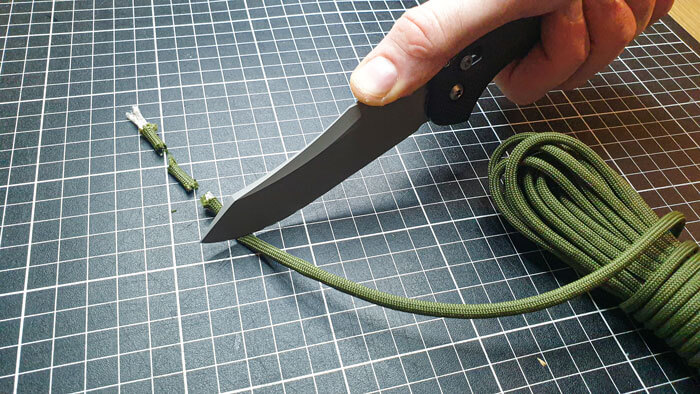
Score: 7/10
A reverse tanto with some serration and you have a knife that’s as good at cutting rope and fishing line as pretty much anything else. Most reverse tantos have a very similar experience in this category as you would have with a clip or drop point. With the Osborne style tanto on the Benchmade Contego or EDC 940, you can really choke up on the blade and even put your thumb in that concave section of the spine to use the tip with exceptional downforce, making cutting through even very thick and tough ropes rather easy.
Reverse Tanto for Self Defense
Score: 8/10
I suppose it could be argued that the American tanto or perhaps the spear point is better for self-defense but at the end of the day, the differences are going to be marginal. Everything we love about the American tanto for self-defense is present in the reverse tanto, from the exceptionally strong and reliable tip to the fact that it’s angular and has a low amount of friction when penetrating thick material.
Reverse Tanto for First Response and Egress
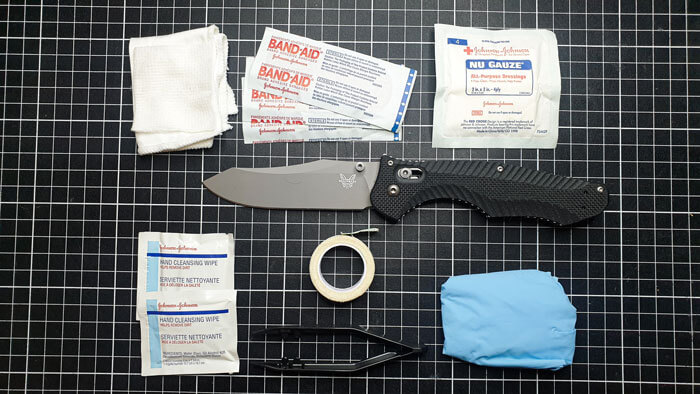
Score: 8/10
The only downfall I see here is that the tip is so pronounced that it may be a little sketchy working in tight spaces near human flesh, for example, cutting the seatbelt off of a wounded car accident patient, but overall, I’d say the reverse tanto gets the job done so long as you’re careful and you’ve had some practice with that sharp point. Since the reverse tanto has incredible piercing capability, it makes for a great knife in terms of cutting open thick and hard materials. Mine went through an aluminum trailer door with relative ease if that’s any consolation.
Reverse Tanto for Combat and Tactical Applications
Score: 7/10
I wouldn’t say that the first thing I think of when getting my hands on a reverse tanto is its capability to be used in combat, but since most knives carried into combat arent really used for violence anyway, I’d say knives with a reverse tanto are as good as anything else in terms of being utilized by a solider or operator. Versatility is often a characteristic we like to have in a knife for use in a combat zone and the reverse tanto offers a ton of that. From use in survival and camp situations to gear and weapon maintenance, the reverse tanto has features that are favorable for each.
Reverse Tanto for Cooking
Score: 7/10
The reverse tanto isn’t exactly known for its exceptional use in cooking but its long and smooth cutting belly makes it quite easy to use in a pinch or while out camping. The only complaint I could see here is that some reverse tanto equipped blades are quite thick at the top near the spine which creates a bit of a wedging effect, so you won’t exactly get super thin and precise slices off of your tomatoes through and through, but other than that, the reverse tanto should perform just about as good as anything else.
Reverse Tanto Use Case Assessment Table
| Use Case | Overall Score |
| Slicing and Skinning | 6 out of 10 |
| Stabbing and Puncturing | 9 out of 10 |
| Batoning | 6 out of 10 |
| Slashing | 8 out of 10 |
| Whittling | 7 out of 10 |
| Prying | 8 out of 10 |
| Everyday Carry (EDC) | 9 out of 10 |
| Camping and Bushcraft | 6 out of 10 |
| Fishing Line and Ropes | 7 out of 10 |
| Self Defense | 8 out of 10 |
| First Response and Egress | 8 out of 10 |
| Combat and Tactical | 7 out of 10 |
| Cooking | 7 out of 10 |
Reverse Tanto Versus Other Popular Blade Shapes
Reverse Tanto vs Drop Point
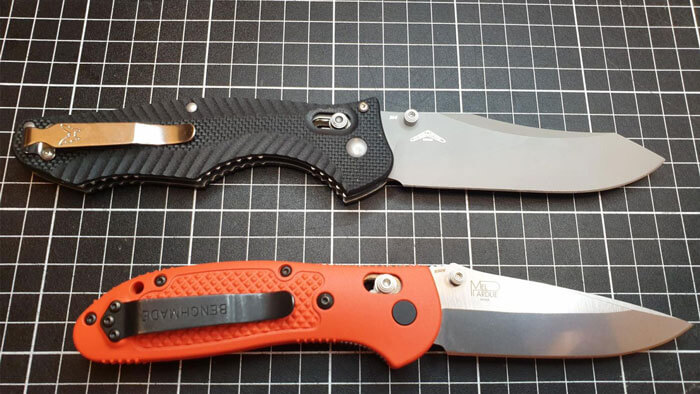
The primary differences here are going to revolve around the tip of the blade. The belly of the blade between the two is almost the same, with the belly of the reverse tanto maybe reaching up a tad higher, but only marginally. The drop point is not going to do well in competing against the reverse tanto when it comes to piercing, as the reverse tanto generally has a triangular-shaped point specifically with a lot of thickness behind and above it, making it the obvious winner for piercing. Yes, the drop point is well known as one of the most versatile blade shapes but in my honest opinion, I think the reverse tanto might deserve a shot at the throne because it not only has exceptional versatility along the length of its spine but also has that added benefit of a very strong tip.
Reverse Tanto vs Tanto
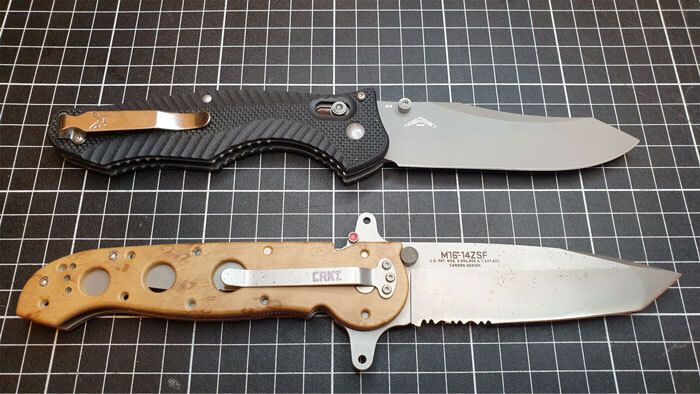
The tanto, mostly speaking about the American version, has two edge surfaces that need to be sharpened basically in a separate fashion, which makes maintenance obviously a bit more tricky than on the reverse tantos belly. The tip, which is probably where most people want to compare and contrast performance, is kind of up for debate. Yes, the American tanto has a long reputation of being capable of piercing thick material and even some types of body armor, but I would argue that the science and geometry that’s gone into a well designed reverse tanto is going to perform almost, or perhaps even as good, as a tanto would. Of course, a tanto is relatively useful and versatile among other things as well, but I and many others prefer the long uninterrupted belly of the blade on the reverse tanto, so all in all, I’d say as a general EDC kind of blade, the reverse tanto might be a bit more user-friendly, while the American tanto might have a slight advantage in penetration but only marginal.
Reverse Tanto vs Clip Point
This comparison is kind of ironic because the two operate and feel very similar to each other. The advantages of the clip point, being that it’s got a thin and easy-to-use tip in tight spaces are also typically found on the reverse tanto, but overall, reverse tanto blades generally have a thicker spine, making them less exceptional for slicing but stronger for piercing.
Reverse Tanto vs Trailing Point
The trailing point is obviously going to decimate the reverse tanto in terms of skinning, slicing, and very precise work on relatively soft materials while the reverse tanto is the obvious choice when strength and durability are needed for things like piercing and work with heavy and thick materials.
Reverse Tanto vs Sheepsfoot
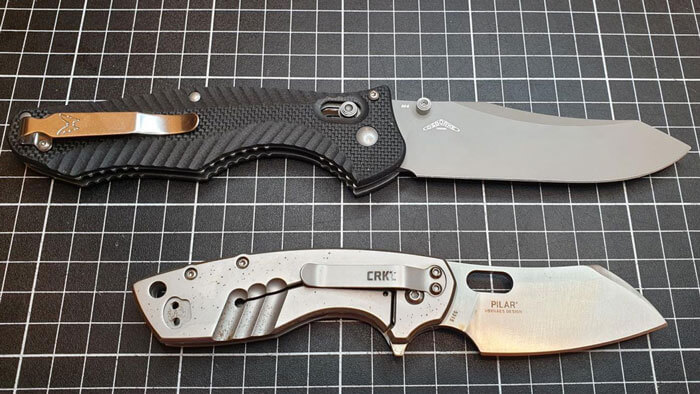
The Sheepsfoot blade and the reverse tanto, depending on the design itself, can share many similarities while the only real consistent difference is that the reverse tanto typically has a flatter spine where it angles down into the tip as opposed to the sheepsfoot where the spine generally slopes down with some curvature to it. In practice, this difference is actually not that drastic and both blade shapes tend to perform relatively similar across the board, with perhaps piercing capabilities favoring the reverse tanto. In general, you’ll find a lot more options in the sheepsfoot blade category (not the Pilar pictured above) that have a flat or mostly flat cutting surface as opposed to reverse tanto blades that will always have at least some curved cutting surface.
Reverse Tanto vs Wharncliffe
The Wharncliffe blade shape is actually very similar to the reverse tanto, especially near the tip. The key difference here among the traditional idea of the design is that the Wharncliffe is host to a very flat cutting edge all the way from the handle to the tip, while the reverse tanto generally has a sloping cutting surface more like the drop point. It’s kind of funny that the Dozier version of the reverse tanto is very often interchangeably dubbed a Wharncliffe and vice versa, so we won’t really compare/contrast those two. The Osborn version of the reverse tanto has some obvious differences from the Wharncliffe, including, on average, a thicker spine, making it better for piercing. Usually, the Wharncliffe blade shape is going to be used on blades that are generally thinner by nature, making them the better slicer but weaker overall blade shape.
Popularity and Accessibility of the Reverse Tanto Blade Shape
The American version of the tanto came out in the early ’80s and while it was limited to really just a couple brands at the time, it’s taken off and is available from just about any of the popular knife brands of today.
The reverse tanto I think is going to take a very similar trajectory. It was first introduced somewhere in the late ’80s or possibly the early ’90s and while it wasn’t something immediately adopted by all brands right off the bat, nowadays you can expect to find at least a couple of iterations of the reverse tanto among most popular brands lineup of knives.
Benchmade, with the help of Warren Osborne, really led the way in popularizing at least their version, the Osborn Reverse Tanto, which is the more angular version and still does a lot of the heavy lifting even at the time of writing this. The other popular style of reverse tanto was popularized by Bob Dozier and has a less aggressively sloped tip and sometimes does away with the angular corner on the spine, but the two are pretty close in function.
For now, the tanto and of course a few other blade shapes like the drop point, clip point, and trailing points are going to be a bit more accessible with more options available. The reverse tanto isn’t exactly an easy shape for a manufacturer to work with as there is a lot of geometry and also freedom for creativity with this particular shape, but for the most part, we’re starting to see a lot of new models come out recently incorporating the reverse tanto, especially since more and more people are recognizing the reverse tanto as a blade with great utility and durability as opposed to just being a novelty aesthetic piece.
Common Grind Types for Reverse Tanto Blades
This is a tough section to answer in a concise manner due to the simple fact that the reverse tanto has so much creative freedom in its form factor. Some reverse tantos are very simple and resemble an American tanto flipped upside down and encompass one single grind throughout the blade, something like a V grind or a chisel grind.
Others, like the Benchmade Contego, are using a complex compound grind where they can thin out the spine in the middle but leave a large amount of material right around the tip and encompassing an overall blade thickness that’s quite a bit thicker than the usual pocket knife blade but also cutting out some unnecessary material and weight in the center of the blade.
There is no one single grind type you can expect to see across all blades utilizing a reverse tanto and, just like the American tanto, some manufacturers may even opt to use multiple grinds on the same blade to achieve a certain aesthetical appeal or even to create a thinner area around the early parts of the belly and then a much thicker component near the tip, as to create a blade that has good slicing capabilities with a tip that you are comfortable using to pierce and puncture heavy materials.
Marine Approved Examples of Folding Tanto Blades (3)
- Benchmade EDC 940

- Kershaw Decibel

- Zero Tolerance 0762

Marine Approved Examples of Fixed Blade Tanto Blades (3)
- Boker Solingen AK1

- Benchmade Contego Osborn 183 (both fixed and folding versions available)

- Boker Magnum Tiger Lily

Wrap Up

The reverse tanto blade shape is one of uniqueness and interesting characteristics and although it definitely looks cool and has many creative iterations, it would be a mistake to overlook the shape’s incredible versatility and strength. Many of the top knife-making brands have already or are working on their version of a reverse tanto and I do believe these will only continue becoming more and more popular as they not only make for a great EDC knife but also perform well in pretty much every category.
Even the rugged and durable reverse tanto becomes more of a liability than an asset with a low quality and slippery handle, so make sure to check out the Marine Approved guide on knife handle materials before you go shopping for a shiny new reverse tanto-equipped blade! If you have any questions about reverse tanto uses or want to share your experiences with this blade shape, comment below!

